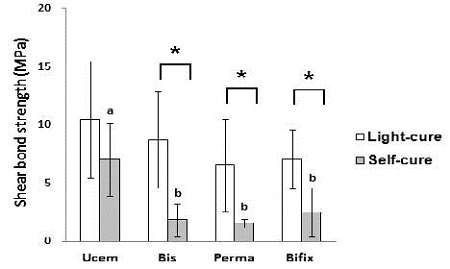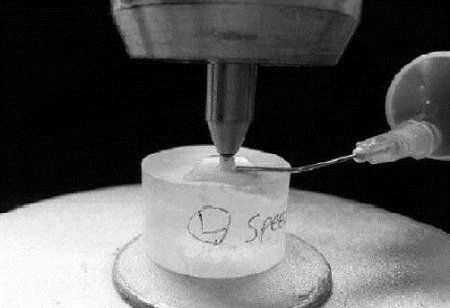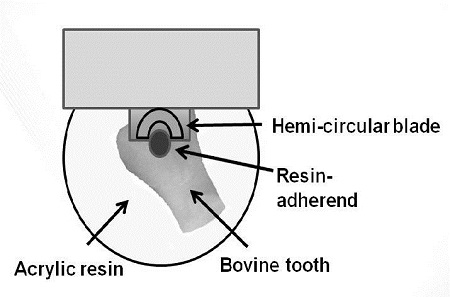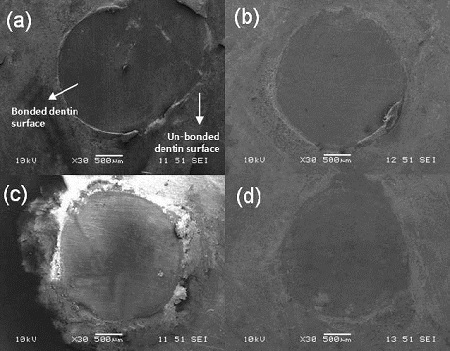
Effect of polymerization mode of self-adhesive resin cement on the shear bond strength
The purpose of this study was to evaluate the shear bond strengths of self-adhesive resin cements between resin adherend and bovine tooth according to polymerization mode. Self-adhesive resin cements used in the study were Bifix SE (Bifix), BisCem (Bis), PermaCem 2.0 (Perma) and U-Cem (UCem). Both self-cure and light-cure mode were performed for each resin cement. Bovine teeth were used and resin adherend block (2.3 mm in diameter × 2.2 mm in height) using composite resin were fabricated. In the case of self-cure mode, specimen were maintained for the setting time specified by manufacturer plus additional 30 minutes under 5 N load and then held in the 37°C dry oven for 90 minutes. In light-cure mode, each surface was light-cured for 20 seconds under the load of 5 N and the process was repeated two times. Then, they were put in the 37°C dry oven for post-irradation time or equivalent specified by the manufacturer plus additional 30 minutes. The shear bond strength was measured by using a universal testing machine (Z020, Zwick, Ulm, Germany) with cross-head speed of 0.75 mm/min with hemi-circular blade. There were no significant differences in the shear bond strengths among the self-adhesive resin cements in light-cure mode. In self-cure mode, the shear bond strength of UCem was significantly higher than others(p<0.05). For UCem, there was no significant difference in shear bond strength between self-cure and light-cure mode(p>0.05). However, the shear bond strengths of Bifix, Bis, and Perma decreased significantly in self-cure mode(p<0.05). For failure patterns, the resin cement was mainly attached to the resin adherend. Therefore, the shear bond strength of UCem in self-cure mode was the highest and was as high as in light-cure mode. Light-cure should be performed to achieve sufficient bond strength in Bifix, Bis, and Perma.
Keywords:
Self-adhesive resin cement, Shear bond strength, Bovine teeth, Adherend, olymerization mode서 론
레진 제재 시멘트는 간접 수복물의 합착을 위해 널리 사용되고 있다. 레진 제재 시멘트는 결합강도가 우수하고, water-based cement에 비해 경화시간이 짧으며 용해도가 낮아 기계적 성질이 우수하다(Love 와 Purton, 1998; Attar 등, 2003). 또한 투명도가 우수하고 표면이 활택하여 심미적이기 때문에 도재와 복합레진 등의 심미 수복재료들의 발전으로 인해 사용이 점점 증가하고 있다(Mak 등, 2002; Stewart 등, 2002).
레진 제재 시멘트는 뛰어난 물리적 성질에도 불구하고 치아와 피착재에 산부식 및 primer와 adhesive 도포 하는 술식 과정이 복잡하고 민감하여 사용하기가 쉽지 않았으나(Brunton 과 Christensen, 2005), 치아에 산부식 또는 primer 및 adhesive 도포하는 전처리 과정이 생략된 자가접착 레진시멘트가 최근에 개발되어 적용되고 있다(Trevor, 2005). 자가접착 레진시멘트의 구성성분은 인산그룹과 염기성 충진재로 구성된다(Ferracane 등, 2011). 자가접착 레진시멘트는 다기능의 phosphoric acid methacrylates를 포함하고 있으며, 이 인산기가 접착 초기에 낮은 pH환경과 친수성의 성질을 제공한다. 이어 단량체의 음전하를 띄는 그룹이 치아의 칼슘이온과 결합하고 필러의 알칼리성 부분과 함께 중화반응을 일으킨다(Behr 등, 2004; Cobb 등, 2004).
레진 제재 시멘트는 중합방법에 따라 자가중합, 광중합, 이중 중합 형태로 분류할 수 있다. 중합의 정도는 물리적 성질, 체적 안정성, 생체 적합성, 용해도, 색상 변화 등에 영향을 주기 때문에 수복물의 성공에 중요한 역할을 한다(Ferracane, 1985). 레진시멘트의 중합 방식에 따른 차이점이 있다면 자가중합 방식은 균일하게 경화되고 작업 시간이 길어 조작이 용이하나 보철물의 변연부에서 결과가 좋지 않을 수 있으며, 광중합 방식은 도재 및 비니어 등의 접착에 유용하게 사용되지만 레진의 빛에 대한 반투과성 때문에 완전한 중합이 어렵다(Li, 1999). 이중 중합 방식은 자가중합과 광중합의 장점을 동시에 갖고 있어 물리적 강도가 높고 심미성이 뛰어나며, 빛이 도달하지 않는 깊은 부위에서 중합이 용이하고, 원하는 시기에 중합을 유도할 수 있으며, 경화 시간을 단축시킬 수 있는 장점을 갖고 있다(El-Mowafy 와 Rubo, 2000; Mitchell 등, 2000; Caughman, 2002). 일반적으로 이중 중합 복합레진은 광중합을 추가로 할 경우 더 높은 중합도를 보이며, 이중 중합 레진시멘트 또한 광중합을 할 경우 더 높은 중합도와 미세경도를 보인다고 알려져 있다(Cadenaro 등, 2010).
선행연구에서 우치를 아크릴릭 레진으로 포매하여 노출시킨 superficial dentin과 레진 피착재 사이에 자가접착 레진시멘트를 적용하고 광중합한 후 중합 후 유지시간(post-irradiation time)을 5분을 추가하여 전단결합강도를 측정하였다(Kim 등, 2013). ISO/WD 16506 #4에서는 위와 같이 피착재가 부착된 시편은 실제 임상에서의 경우보다 열용량이 크다고 하였다. 게다가 접착된 시편은 시험 전까지 37°C 증류수에 24시간 동안 보관을 하는데 접착된 시편의 물이 증발되면 잠열이 증발되어 온도상승을 지연 시킨다. 따라서 접착된 시편의 온도 상승률이 실제 임상에서 보다 더 천천히 이뤄진다. 그렇기 때문에 실제 임상에 비해 충분한 중합 후 유지시간이 주어져야 한다.
따라서, 본 연구의 목적은 이중 중합형의 자가접착 레진시멘트를 광중합 모드와 자가중합 모드를 시행하여 중합방법에 따른 전단결합강도를 비교하고, 중합 후 유지시간을 증가시켰을 때의 전단결합강도를 평가하여 치아와 피착재 사이의 결합강도를 향상 시킬 수 있는 중합방법과 조건을 알아보고, 장기적인 수복물의 유지력을 향상 시킬 수 있는 우수한 자가접착 레진시멘트를 찾아 임상에서 가이드라인(guideline)으로 삼고자 한다.
재료 및 방법
1. 실험 재료
본 연구에는 4가지 자가접착 레진시멘트가 실험에 사용되었으며 모두 dual-cure type 이였다(Table 1). 전단결합강도 실험에서 시멘트별로 5개의 시편을 제작하였다.
실험에 사용된 치아는 발거 후 3일 이내의 우치 중 전치부만 사용하였다. 우치는 증류수에 넣어 4°C에서 냉장 보관하여 사용하였으며, 실험에 사용된 피착재를 제작하기 위해 수복용 복합레진 CLEARFIL AP-X (Kuraray MEDICAL Inc., Kurashiki, Japan)을 이용하였다.
2. 전단결합강도
우치에 접착할 복합레진 블록을 제작하기 위하여 ISO/WD 16506 #4 Dentistry - Polymer-based luting materials containing adhesive components 에 따라 직경 2.3 mm × 높이 2.2 mm의 원통형의 복합레진 피착재를 제작하였다.
3일 이내에 발거된 40개의 우식이 없는 우치를 백악법랑경계에서 치근부분은 절단하고 치관부분을 사용하였으며 치수를 제거하고 utility wax로 매립하였다. 그 다음 복합레진 피착재의 접착할 부위를 아래로 향하게 한 후 고정한 후, 원통형 테플론 몰드에 교정용 아크릴릭 레진(Ortho-Jet, Lang Dental Manufacturing co., Wheeling, USA)을 사용하여 포매 하였다. 그 다음 연마지 120번, 400번을 사용하여 superficial dentin이 노출될 때까지 연마한 후 밀폐된 용기안의 37°C 증류수에 보관하였다.
포매한 40개의 치아시편은 자가접착 레진시멘트의 종류와 중합방법에 따라 실험군을 5개씩 분류하였다. 접착 전에 치면을 10초간 수세 후 우치의 superficial dentin의 접착부위는 평평한 형태의 물이 젖어 있는 상태로 유지하고, 나머지 부위는 여과지를 사용하여 닦아내었다. 복합레진 피착재에 CLEARFIL CERAMIC PRIMER (Kuraray MEDICAL Inc., kurashiki, Japan)를 5초간 적용 후 건조하였다. 건조한 면에 4가지 자가접착 레진시멘트를 각각 도포하여 치면에 접착한 후 5 N의 하중을 가한 후 과잉의 레진시멘트를 제거한 후 oxygen shielding 재료를 1 mm 의 직경과 두께로 복합레진 피착재 변연부에 도포하였다(Figure 1).
자가중합의 경우 5 N의 하중을 가한 상태에서 각 제조사의 경화시간에 30분을 더한 시간만큼 두었다가 하중을 제거하고 37°C dry oven안에서 90분을 더 유지 하였다. 광중합의 경우 5 N의 하중을 가한 상태로 면 당 20초씩 광중합을 2회 반복한 후 제조사가 지시한 중합 후 유지시간에 30분을 더하여 37°C dry oven안에서 유지하였다. 접착된 시편은 시험 전까지 37°C 증류수에 24시간 동안 보관하였다. 전단결합강도는 만능시험기(Z020, Zwick, Ulm, Germany)를 이용하여 0.75 mm/min cross-head speed로 측정하였으며 사용된 지그는 Figure 2과 같다.
3. 파절양상
파절이 일어난 시편의 파절양상을 5배 확대경으로 관찰하였다. 파절양상은 접착성 파절, 응집성 파절, 혼합형 파절로 구분하였다.
4. 통계분석
통계분석은 SPSS 프로그램(SPSS 12.0; SPSS GmbH, Munich, Germany)을 이용하였다. 모든 실험군의 전단결합강도를 one-way ANOVA로 신뢰수준 95%에서 분석하였고, 사후검정으로 Duncan’s multiple range test를 시행하였다.
결 과
1. 전단결합강도
자가접착 레진시멘트의 전단결합강도는 Figure 3와 같다. 광중합 모드의 경우, 전단결합강도는 자가접착 레진시멘트간에 유의성 있는 차이가 없었다(p>0.05). 자가중합 모드의 경우, UCem이 다른 자가접착 레진시멘트 보다 유의성있게 높게 나타났다(p<0.05). 자가중합과 광중합 모드간의 전단결합강도의 차이를 살펴보면, UCem의 경우 유의성 있는 차이가 없었으나(p>0.05), 그 외의 Bifix, Bis와 Perma은 자가중합만 한 시편의 전단결합강도가 광중합을 시행한 시편보다 유의성 있게 낮았다(p<0.05).

Shear bond strengths of the resin-based cements with light-cure and self-cure mode. Different lowercase letters mean the statistical difference among the self-cure group (One-way ANOVA and Duncan's multiple range test at α=0.05).* means significant difference between light-cure and self-cure mode by paired t-test(α=0.05).
2. 파절양상
자가접착 레진시멘트의 파절양상은 광중합 모드는 Figure 4, 자가중합 모드는 Figure 5와 같다. 자가접착 레진시멘트의 광중합 모드와 자가중합 모드 모두 접착성 파절이 관찰되었는데, 레진시멘트가 복합레진 피착재에 모두 100% 접착되어 있었다.

In self-cure mode, scanning electron microscope image of adhesive failure at dentin (original magnification 30x). A: Bifix, B: Bis, C: Perma, D: UCem.
고 찰
본 연구에서는 이중 중합형의 자가접착 레진시멘트를 광중합 모드와 자가중합 모드를 시행하여 중합방법에 따른 전단결합강도와 중합 후 유지시간을 이전 연구에 비해 증가시켰을 때의 전단결합강도를 평가하여 치아와 피착재 사이의 결합강도를 향상 시킬 수 있는 중합방법과 조건을 알아보고자 하였다.
자가접착 레진시멘트의 전단결합강도는 광중합 모드에서는 자가접착 레진시멘트간의 유의성 있는 차이를 보이지 않았지만, 자가중합 모드에서 UCem이 다른 자가접착 레진시멘트에 비해 높은 전단결합강도를 보였다. 또한 광중합 모드에서도 UCem이 유의성 있는 차이를 보이지 않았지만 높은 전단결합강도를 보였다. 이는 UCem의 구성성분 중 4-META가 들어있는데, 4-META를 접착성 레진에 넣어 사용하게 되면 상아질에 대한 접착력을 높인다고 보고되고 있으며, 4-META와 같은 접착을 촉진하는 단량체가 포함된 접착성 레진은 탈회된 치면의 내부로 확산, 침투하여 상아질과 레진의 hybrid layer를 형성함으로써 상아질에 대한 접착강도가 높아진다는 연구결과가 있다(Nakabayashi 등, 1992). 위의 이유로 UCem의 구성성분의 4-META가 접착성 성분을 포함하여 높은 전단결합강도를 보인 것이라 사료된다.
UCem의 자가중합과 광중합 모드간의 전단결합강도가 유의성 있는 차이를 보이지 않았다. 이와 같은 이유는 레진시멘트에서 물리적 성질은 중합율과 밀접한 관련이 있는데(Haitz 등, 1995), UCem이 단량체와 개시제의 조성을 통해 충분한 중합율을 만족시켰으며, 높은 중합율은 재료에 표면 경도와 강도를 갖는 다는 연구결과처럼(Ozturk 등, 2005), 본 연구에서도 UCem은 단량체와 개시제의 함량 조절과 그밖의 필러의 함량 조절 및 조성을 통해 중합율과 반응속도를 높여 자가중합만 시행하였음에도 높은 전단결합강도를 나타내었을 것으로 사료된다.
나머지 자가접착 레진시멘트인 Bifix, Bis, Perma는 광중합 모드가 자가중합 모드 보다 유의성 있게 높은 전단결합강도를 보였다. UCem도 유의성 있는 차이는 없었지만 광중합 모드가 자가중합 모드 보다 높은 전단결합강도를 보였다. 이와 같은 이유는 모든 자가접착 레진시멘트는 산성의 단량체를 갖고 있으며 이중 중합 레진시멘트 안에 있는 amine initiator와 반응을 하여 중합율에 영향을 미치는데 이를 극복하기 위해 aryl-borate salt 또는 sodium aryl sulfate와 같은 중합개시 시스템을 레진시멘트 안에 넣게 된다(Mazzitelli 등, 2008). 이러한 중합 시스템은 초기의 낮은 중합도의 결과를 나타낼 수 있으며 계속적으로 중합도에 영향을 미치게 된다(Tezvergil-Mutluay 등, 2007). 따라서 광중합을 실시하였을 때 더 높은 전단결합강도가 나타났을 거라 사료된다. 선행 연구에서도 광중합을 한 이중 중합 레진시멘트에서 더 높은 전단결합강도를 보이며, 불충분한 중합이 접착력을 떨어뜨린다는 연구 보고가 있다(Piwowarczyk 등, 2007).
레진의 중합도는 레진의 기질안에 함유된 메타크릴레이트의 이중결합이 반응한 정도를 의미하며, 100%의 중합도를 얻는 것은 불가능 하여 미반응 단량체가 존재하게 된다. 광중합시 중합 광강도와 중합시간에 의해 중합이 되며, 자가중합시 benzoyl peroxide와 같은 개시제와 3차 아민의 촉진제가 반응할 수 있는 중합시간에 의해 중합이 이루어지며, 중합도가 높을수록 물리적 성질이 좋아지고 수복물의 수명이 연장될 수 있으며, 강도와 경도 및 색 안전성을 증가 시킬 수 있다(Feilzer 등, 1995). 따라서 중합 후 유지시간을 더 늘릴수록 중합도를 더 높이고 결합강도가 더 증가할 거라 예상이 되어 선행연구(Kim 등, 2013)에서 광중합 후 중합 후 유지시간을 5분을 유지한 반면에 본 연구에서는 광중합 후 중합 후 유지시간을 30분을 유지하였을 때의 전단결합강도를 측정하여 비교하였다. 그 결과 Bis와 Bifix가 선행 연구(Kim 등, 2013)보다 본 연구결과에서 약간 높은 전단결합강도를 보였지만 유의성 있는 차이가 없었다. 이는 중합 후 유지시간을 늘려도 전단결합강도에 큰 영향을 미치지 않았음을 알 수 있었다. Yan 등(2010)의 연구에서도 중합 후 유지시간이 재료의 경도에 영향을 미치지 못하여 중합 후 유지시간의 정도가 재료의 물성에 큰 영향을 끼치지 못함을 알 수 있었다. 중합 후 유지시간이 결합강도에 영향을 미치지 않은 이유로는 자가접착 레진시멘트의 제조사가 지시하는 경화시간이 보통 4분에서 길게는 8분까지 명시되어 이 시간 안에 자가접착 레진시멘트가 충분히 중합이 되었기 때문으로 보여지며, 이에 따라 중합 후 유지시간이 30분까지 주어지지 않아도 됨을 알 수 있었다.
파절양상은 Figure 4와 Figure 5처럼 모든 자가접착 레진시멘트가 피착재에 100%로 붙어있는 접착성 파절을 보였다. 이는 레진시멘트와 레진 피착재가 같은 레진계이고, 오래된 레진에는 미반응 이중결합이 적어 잘 접착이 안 되지만 본 실험에서처럼 당일 제작한 fresh한 레진에는 미 반응 double bond가 많아 레진시멘트와 결합이 용이하였을 것이다(Ronald 와 John, 2012). Hitz 등(2012)의 연구에서도 치아와 자가접착 레진시멘트와의 전단결합강도와 ceramic과 자가접착 레진 시멘트와의 결합강도를 비교한 결과 세라믹과 자가접착 레진시멘트와의 결합강도가 더 높게 나타났다. 이러한 결과로 미루어 보아 레진시멘트가 치아보다 피착재와 결합강도가 더 강하다는 것을 보여주고 있다. 따라서 치아와의 자가접착 레진 시멘트의 결합강도를 더 높이기 위한 많은 연구가 필요하다고 사료된다.
본 연구의 한계점은 우치의 상아질을 사용하였다는 점이다. 하지만 Rüttermann 등(2013)의 연구에서는 사람의 치아와 우치의 법랑질과 상아질의 전단결합강도가 유의성 있는 차이를 보이지 않았다고 보고하였다. 이에 따라 본 연구의 결과를 비교적 신뢰할 수 있을 것이라 사료된다.
본 연구를 통해서 이중 중합 자가접착 레진시멘트의 경우 UCem이 치아에 전처리 과정이 간단하면서도 높은 결합강도를 보여 임상에서 유용하게 사용 될 거라 예상되며, UCem을 제외한 다른 이중 중합형 자가접착 레진시멘트는 충분한 결합강도를 내기 위하여 광중합을 시행해야 한다고 사료된다.
결 론
이중 중합형 자가접착 레진 시멘트의 중합방법에 따른 전단결합강도와 파절양상을 비교 평가한 결과 다음과 같은 결론을 얻었다.
1.광중합 모드에서 자가접착 레진시멘트간의 전단결합강도는 유의성있는 차이가 없었다(P>0.05).
2.자가중합 모드에서 UCem의 결합강도가 다른 자가접착 레진시멘트 보다 유의성 있게 높게 나타났다(P<0.05).
3.UCem은 자가중합과 광중합 모드간에 유의성 있는 차이가 없었으나(P>0.05), 나머지 시멘트는 자가중합 모드가 광중합 모드보다 결합강도가 유의성 있게 낮았다(P<0.05).
4.파절양상은 레진시멘트가 주로 복합레진 블록에 붙어 파절 되었다.
본 연구에 따르면 이중 중합 자가접착 레진시멘트의 경우 UCem을 제외한 다른 레진시멘트는 충분한 결합강도를 내기 위하여 광중합을 시행해야 한다.
Notes
References
-
N Attar, LE Tam, D McComb, Mechanical and physical properties of contemporary dental luting agents, J Prosthet Dent, (2003), 89, p127-134.
[https://doi.org/10.1067/mpr.2003.20]

- M Behr, M Rosentritt, T Regnet, R Lang, G Handle, Marginal adaptation in dentin of a selfadhesive universal resin cement compared with well-tried systems, Dent Mater J, (2004), 20, p191-197.
-
K Bitter, H Meyer-Lueckel, K Priehn, JP Kanjuparambil, K Neumann, AM Kielbassa, Effects of luting agent and thermocycling on bond strengths to root canal dentine, Int Endod J, (2006), 39, p809-18.
[https://doi.org/10.1111/j.1365-2591.2006.01155.x]

-
PA Brunton, GJ Christensen, Contemporary dental practice in the UK indirect restorations and fixed prosthodontics, British Dental Journal, (2005), 198, p99-103.
[https://doi.org/10.1038/sj.bdj.4811980]

- M Cadenaro, CO Navarra, F Antoniolli, A Mazzoni, R Di Lenarda, FA Rueggeberg, L Breschi, The effect of curing mode on extent of polymerization and microhardness of dual-cured, selfadhesive resin cements, Am J Dent, (2010), 23, p14-8.
- WF Caughman, FA Rueggeberg, Shedding new light on composite polymerization, Oper Dent, (2002), 27, p636-638.
- D Cobb, Timmons, C Stanford, D Dawson, G Denehy, M Vargas, Clinical outcomes of ceramic inlays/ onlays luted with two bonding systems, J Dent Res, (2004), 83, p1539.
- J De Munck, M Vargas, K Van Landuyt, K Hikita, P Lambrechts, B VanMeerbeek, Bonding of an auto-adhesive luting material to enamel and dentin, Dent Mater J, (2004), 20, p963-971.
- OM El-Mowafy, MH Rubo, Influence of composite inlay/onlay thickness on hardening of dualcured resin cements, J Can Dent Assoc, (2000), 66, p1-5.
-
AJ Feilzer, LH Dooren, AJ de Gee, CL Davidson, Influence of light intensity on polymerization shrinkage and integrity of restoration-cavity interface, Eur J Oral Sci, (1995), 103, p322-6.
[https://doi.org/10.1111/j.1600-0722.1995.tb00033.x]

-
JL Ferracane, Correlation between hardness and degree of conversion during the setting reaction of unfilled dental restorative resins, Dent Mater, (1985), 1, p11-14.
[https://doi.org/10.1016/S0109-5641(85)80058-0]

- JL Ferracane, JW Stansbury, FJ Burke, Selfadhesive resin cements - chemistry, properties and clinical considerations, J Oral Rehabil, (2011), 38, p295-314.
- RH Haitz, MG Craford, RH Wiessman, Handbook of Optics. 2nd, NewYork:McGraw Hill, (1995), p121-129.
-
EA Hasegawa, DB Boyer, DC Chan, Hardening of dual-cured cements under composite resin inlays, J Prosthet Dent, (1991), 66, p187-192.
[https://doi.org/10.1016/S0022-3913(05)80046-0]

-
T Hitz, B Stawarczyk, J Fischer, CH Hämmerle, I Sailer, Are self -adhesive resin cements a valid alternative to conventional resin cements? A laboratory study of the long-term bond strength, Dent Mater, (2012), 28, p1183-1190.
[https://doi.org/10.1016/j.dental.2012.09.006]

-
C Holderegger, I Sailer, C Schuhmacher, R Schläpfer, C Hämmerle, J Fischer, Shear bond strength of resin cements to human dentin, Dent Mater, (2008), 24, p944-50.
[https://doi.org/10.1016/j.dental.2007.11.021]

- International Organization for standardization, ISO/WD 16506 #4. Dentistry - Polymer-based luting materials containing adhesive components, Geneva: Switzerland, ISO, (2013).
- AJ Kim, SH Yu, Sh Oh, JM Bae, Shear bond strength, flexural strength, water sorption, solubility of self-adhesive resin cement, Kor J Den Mater, (2013), 40, p57-64.
- ZC Li, Mechanical properties of dental luting cements, J Prosthet Dent, (1999), 81, p597-609.
-
RM Love, DG Purton, Retention of posts with resin, glass ionomer and hybrid cements, J Dent, (1998), 26, p599-602.
[https://doi.org/10.1016/S0300-5712(97)00043-2]

- YF Mak, SC Lai, GS Cheung, AW Chan, FR Tay, DH Pashley, Microtensile bond testing of resin cements to dentin and an indirect resin composite, Dent Mater, (2002), 18, p609-621.
-
N Ozturk, A Uwumez, S Usumez, Degree of conversion and surface hardness of resin cement cured with different curing units, Quintessence Int, (2005), 36, p771-777.
[https://doi.org/10.1016/j.prosdent.2006.03.009]

-
A Piwowarczyk, R Bender, P Ottl, HC Lauer, Long-term bond between dual-polymerizing cementing agents and human hard dental tissue, Dent Mater, (2007), 23, p211-7.
[https://doi.org/10.1016/j.dental.2006.01.012]

- LS Ronald, MP John, Craig’s restorative dental materials. 13th ed. St, Louis:Elsevier, (2012), p335-336.
- S Rüttermann, A Braun, R Janda, Shear bond strength and fracture analysis of human vs. bovine teeth, PLoS One, (2013), 8, pe59181.
-
GP Stewart, P Jain, J Hodges, Shear bond strength of resin cements to both ceramic and dentin, J Prosthet Dent, (2002), 88, p277-284.
[https://doi.org/10.1067/mpr.2002.128034]

-
C1 Mazzitelli, F Monticelli, R Osorio, A Casucci, M Toledano, M Ferrari, Effect of simulated pulpal pressure on self-adhesive cements bonding to dentin, Dent Mater, (2008), 24, p1156-63.
[https://doi.org/10.1016/j.dental.2008.01.005]

- CA Mitchell, M Abbariki, JF Orr, The influence of luting cement on the probabilities of survival and modes of failure of cast fullcoverage crowns, Dent Mater, (2000), 16, p198-206.
- N Nakabayashi, M Ashizawa, M Nakamura, Identification of a resin-dentin hybrid layer in vital human dentin created in vivo: durable bonding to vital dentin, Quintessence Int, (1992), 23, p135-41.
-
A1 Tezvergil-Mutluay, LV Lassila, PK Vallittu, Degree of conversion of dual-cure luting resins light-polymerized through various materials, Acta Odontol Scand, (2007), 65, p201-5.
[https://doi.org/10.1080/00016350701311632]

- FJ Trevor, Trends in Indirect Dentistry: 3. Luting Materials, Dental Update, (2005), 32, p251-260.
-
YL Yan, YK Kim, KH Kim, TY Kwon, Changes in degree of conversion and microhardness of dental resin cement, Oper Dent, (2010), 35, p203-10.
[https://doi.org/10.2341/09-174-L]




